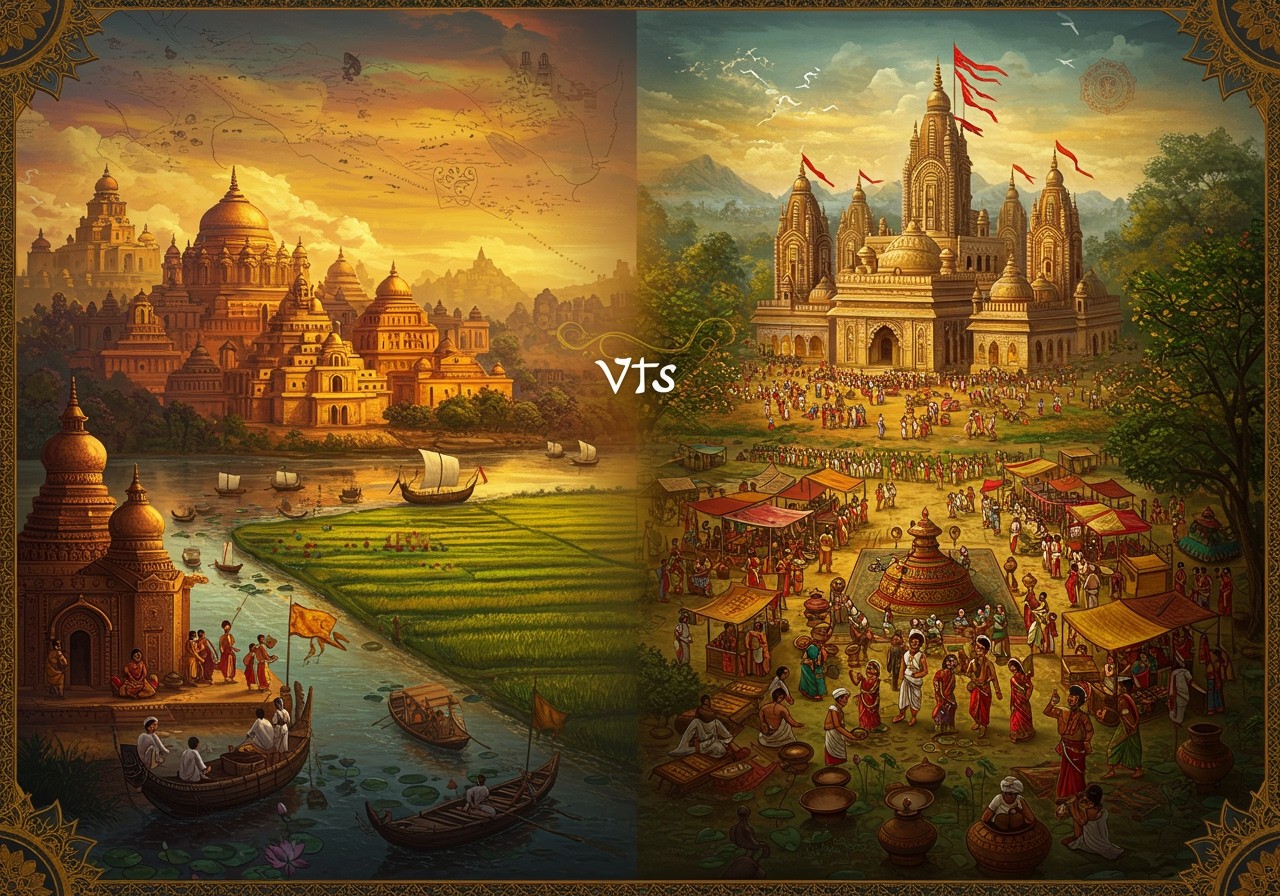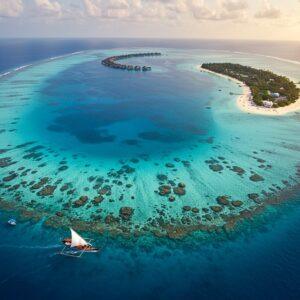
Delving into the historical tapestry of Samatata and Vanga offers a captivating glimpse into Bengal’s rich past. These regions, integral to ancient Bengal, hold significant cultural and political importance for those who cherish Indian traditions. Samatata, encompassing the southeastern coastal area, and Vanga, representing the southwestern deltaic plains, played distinct roles in shaping Bengal’s identity.
Samatata: A Coastal Hub Connecting Bengal to Southeast Asia
Located in present-day Bangladesh, Samatata served as a vital gateway for trade and cultural exchange with Southeast Asia. Its coastal position facilitated maritime connections, fostering interactions with distant lands. Archaeological remnants, including inscriptions and ruins, stand as testaments to Samatata’s vibrant history. Influential Indian dynasties, such as the Chandra and Varman, left their mark on the region’s political landscape. Samatata also played a crucial role in the dissemination of Buddhism, as evidenced by the ancient monasteries and stupas that dot its landscape. The region’s unique geography, characterized by coastal and riverine features, profoundly influenced its socio-political development.
Vanga: The Fertile Delta and its Historical Significance
Vanga, nestled in the fertile plains of southern Bangladesh, finds mention in ancient texts like the Mahabharata and Ramayana, underscoring its historical significance. Its strategic location provided not only abundant agricultural land but also proximity to major rivers like the Ganges and Brahmaputra. Dynasties like the Gangaridai played pivotal roles in defending Vanga against invasions. Archaeological discoveries offer valuable insights into the region’s urban planning and intricate trade networks. Vanga’s contributions to Bengal’s cultural and religious evolution are undeniable.
Comparing Samatata and Vanga: A Study in Contrasts
A comparative analysis of Samatata and Vanga reveals fascinating differences in their geographical and political trajectories. Samatata flourished as a center of maritime trade, while Vanga’s economy relied heavily on agriculture. The ruling dynasties of each region adopted distinct governance styles, shaping their respective political landscapes. Cultural exchanges between these regions played a crucial role in influencing Bengal’s religious fabric. External factors, such as invasions and trade relations, impacted the political stability of both Samatata and Vanga.
Political Dynamics and Influence of Samatata and Vanga
Both Samatata and Vanga held considerable political sway in ancient Bengal. Regional politics often involved complex alliances and occasional conflicts with neighboring territories. These regions played a significant role in the eventual political unification of Bengal under later empires. Their resilience in resisting foreign invasions and maintaining a degree of autonomy contributed to the development of a distinct Bengali identity.
Cultural and Religious Contributions: A Shared Legacy
Samatata played a key role in spreading Buddhism to Southeast Asia, while Vanga served as a prominent center for Hinduism. Both regions showcased remarkable architectural achievements, evident in their magnificent temples and intricate sculptures. Literary contributions, including ancient texts and inscriptions, further enriched Bengal’s cultural heritage. Their influence on the development of the Bengali language and script is undeniable. The continuous cultural exchange between Samatata and Vanga fostered a rich and diverse heritage in the broader Bengal region.
The Political History of Ancient Bengal: A Story of Integration and Independence
The political landscape of ancient Bengal is a fascinating blend of integration into larger empires and periods of regional independence. Let’s journey through the key phases that shaped this vibrant history.
Early Mentions and the Rise of Empires
The earliest recorded political entities in Bengal, the Gangaridai and Prasioi empires, emerge around the time of Alexander the Great’s invasion in 326 B.C. This period marks Bengal’s initial interactions with larger empires, setting the stage for its complex political future.
Influence of Major Empires: Mauryas and Guptas
Bengal became a part of the Maurya Empire (4th to 2nd century B.C.) and later the Gupta Empire (4th-5th century A.D.). Under the Guptas, Bengal flourished as an important province with a system of local self-governance. This period fostered regional identity and laid the groundwork for future independence.
Emergence of Local Kingdoms: Vanga and Gaur
In the first half of the 6th century A.D., southern and eastern Bengal broke away from Gupta rule, establishing the independent Kingdom of Vanga. The Gaur Kingdom arose in 690 A.D., encompassing West Bengal and present-day Bangladesh. However, the period between 650 and 750 A.D. was marked by political instability and upheaval in Gauda.
The Pala and Sena Dynasties: Shaping Bengal’s Identity
The Pala Empire (750-1162 A.D.) represents a period of Bengali strength, particularly during the reigns of Dharmapala and Devapala. Known for their patronage of Buddhism, the Palas left a lasting cultural impact. The Sena Dynasty (1162-1223 A.D.), originating from the Karnata region, consolidated Hinduism in Bengal.
The Bengal Sultanate and Mughal Rule: Cultural Fusion and Transformation
The Bengal Sultanate (c. 1352-1576 CE) ushered in an era of cultural fusion and exchange. In the 16th century, Bengal came under Mughal rule, with Murshidabad in West Bengal serving as the capital of the independent Nawab Bengal (1717–1765).
British Rule and the Partition: A Defining Moment
British control began in 1765, marking a significant shift in Bengal’s political landscape. In August 1947, the Bengal Presidency was divided into West Bengal (India) and East Bengal (later Bangladesh), a pivotal moment that continues to shape the region’s identity.
How Poojn.in Supports Your Ritual Needs
At Poojn.in, we understand the deep significance of Bengali traditions. We offer a wide range of authentic puja samagri, carefully curated to enhance your spiritual practices. Whether you are seeking items for daily worship or special ceremonies, our collection caters to diverse needs.
-
Puja Gadi (Prayer Mats): Find traditional Bengali-style prayer mats, perfect for creating a sacred space in your home. These mats add a touch of authenticity to your daily pujas and special occasions.
-
Brass and Copper Items: Discover authentic brass and copper utensils and containers essential for Bengali rituals. Maintain the sanctity of your traditions with our high-quality offerings.
-
Traditional Asanas: Enhance your comfort during puja with our traditional asanas made from natural materials. Experience the blend of comfort and tradition with our carefully selected asanas.
For personalized guidance in choosing the right items, our team is available to assist you. Contact us via phone at 03369029784 or WhatsApp at 9476142738.
Visit Poojn.in to explore our complete collection and experience the convenience of online shopping for all your puja needs. We deliver across India, bringing the sanctity of tradition to your doorstep.
Conclusion: Reflecting on Bengal’s Enduring Legacy
Bengal’s political history, from ancient empires to modern times, is a testament to the region’s resilience and cultural richness. Understanding this journey provides valuable context for appreciating the traditions and values cherished by culturally rooted Indians. The story of Samatata and Vanga offers a compelling glimpse into this intricate past, reminding us of the enduring legacy that continues to shape Bengal’s identity today.
FAQs about Samatata and Vanga
What distinguished Samatata from Vanga? Samatata thrived on maritime trade and coastal interactions, while Vanga’s strength lay in agriculture and riverine resources. This fundamental difference shaped their economic and political development.
Why are Samatata and Vanga important to Bengal’s history? These regions played distinct yet interconnected roles in Bengal’s political evolution, cultural exchange, and religious development. Studying them enriches our understanding of Bengal’s complex past.
What resources can I explore to learn more about these regions? Historical inscriptions, ancient texts like the Mahabharata and Ramayana, archaeological findings, and scholarly research provide valuable insights into the history and significance of Samatata and Vanga.


